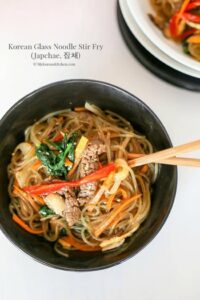“We’ve got vermicelli, bean sprouts and we don’t have beef, so we’ll have pork. And we don’t have peppers, so we’ll have spinach.”
I took the ingredients for lunch out of the fridge, put them on the chopping board and used a knife to cut the vegetables into small pieces.
“Carrots and onions, too.”
This was not what Saki ate for lunch, but the japchae I made for her.
Well, it was more like japchae, because it was made with pork instead of beef, and there were no peppers or paprika.
Spicy food could also improve appetite and relieve fatigue, which was a good thing.
But you have to be careful not to eat too much, because too much is bad for you.
As I was cooking in the kitchen, Saki came walking towards me, probably attracted by the smell.
“Coming down?”
“Lunch will be ready soon.”
“For lunch? (What are you making?)”
“It’s a dish called japchae. But it’s spicy, so Saki, you have fried noodles and vegetable juice.”
“One bite.”
“Huh? I’ve already put in the soy sauce and I’m making it for me, so it’s spicy.”
“Red, eat it.”
“You want something red? Oh, the bean sauce. You don’t want to dilute it?”
“Ai!”
I was thinking of diluting the taste if Saki was going to eat it, but apparently she was interested in the japchae I was making.1
Hmm, I wonder if this is something I should give her? Maybe this could be another experience?
After thinking about it for a while, I gave Saki an empty bowl to hold so that if she couldn’t eat, she could spit it out immediately.
“Are you ready? If you don’t like it, just spit it here. Okay?”
“Yes!”
“Now, open your mouth and say, ‘Aah!'”
As it would be dangerous to feed her too much from the start, I picked up a piece of vermicelli with my chopsticks and brought it to Saki’s mouth.
“Ahhh.”
“How are you doing? Are you okay? If not, spit. Okay?”
“……”
It was a good idea to keep an eye on her to make sure she doesn’t start crying because it was too painful.
“Oh.”
“Oh?”
“It’s good!”
“Eh? Was it good? Really?”
“Kariya! (It’s delicious!)”
“Oh, it’s for adults.”
“It’s a little bit crunchy!”
“Do you want something spicy?”
“Yes!”
I thought about making japchae for Saki’s lunch, but I was worried about her eating too much spicy food at such a young age, so I decided to serve it with a lighter taste.
“Karyakunai… (Not spicy…)”
The children’s version of japchae was not well received, perhaps because the first one was more to her liking.
And from the next day, I would ask Saki,
“What do you want for lunch?”
And the next day, when I asked Saki what she wanted for lunch, she said,
“Kariya-no! (Spicy!)” and “What do you want for dinner?” “Spicy!” and “What do you want for dinner?” “Red food.”
Every time, I scolded her, “Don’t eat too much spicy food, it’s bad for you!”
Why do we have to keep telling 3-year-olds to quit spicy food, as we do for adults who can’t quit?
In addition, after being angered, she lost strength from her whole body and lied on the floor and did not move for a while.
“Saki, today’s lunch…”
“Kariya!”
“Spicy?…”
“It’s so hot!”
“I told you not to do that!”
“It’s hot and it’s red!”
Oh God, she lied flat on her back and started flapping her arms and legs.
It was like she was a complete spice addict.



